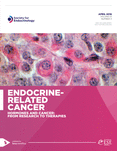A-kinase anchoring protein 2 is required for calcitonin-mediated invasion of cancer cells
- Correspondence should be addressed to G V Shah; Email: shah{at}ulm.edu
Abstract
Expression of neuropeptide calcitonin (CT) and its receptor (CTR) is frequently elevated in prostate cancers (PCs) and activation of CT–CTR axis in non-invasive PC cells induces an invasive phenotype. Specific, cell-permeable inhibitors of protein kinase A abolish CTR-stimulated invasion of PC cells. Since PKA is ubiquitously distributed in cells, the present study examined the mechanism(s) by which CTR-stimulated PKA activity is regulated in time and space. CT reduced cell adhesion but increased invasion of PC cells. Both these actions were abolished by st-Ht31 inhibitory peptide suggesting the involvement of an A-kinase anchoring protein (AKAP) in CT action. Next, we identified the AKAP associated with CT action by the subtraction of potential AKAP candidates using siRNAs. Knock-down of membrane-associated AKAP2, but not other AKAPs, abolished CT-stimulated invasion. Stable knock-down of AKAP2 in PC3-CTR cells remarkably decreased their cell proliferation, invasion, clonogenicity and ability to form orthotopic tumors and distant metastases in nude mice. Re-expression of AKAP2-wt restored these characteristics. Primary PC specimens displayed remarkable upregulation of CTR/AKAP2 expression as compared to benign prostates. Metastatic cancers displayed significantly higher CTR/AKAP2 expression than localized cancers. These results for the first time demonstrate that AKAP2 is expressed in human prostates, its expression is elevated in metastatic prostate cancer, and the knock-down of its expression remarkably decreased tumorigenicity and metastatic ability of prostate cancer cells. AKAP2 may serve as a critical component of CTR-mediated oncogenic actions.
- Revision received 25 September 2015
- Accepted 2 October 2015
- Made available online as an Accepted Preprint 2 October 2015
- © 2016 Society for Endocrinology















